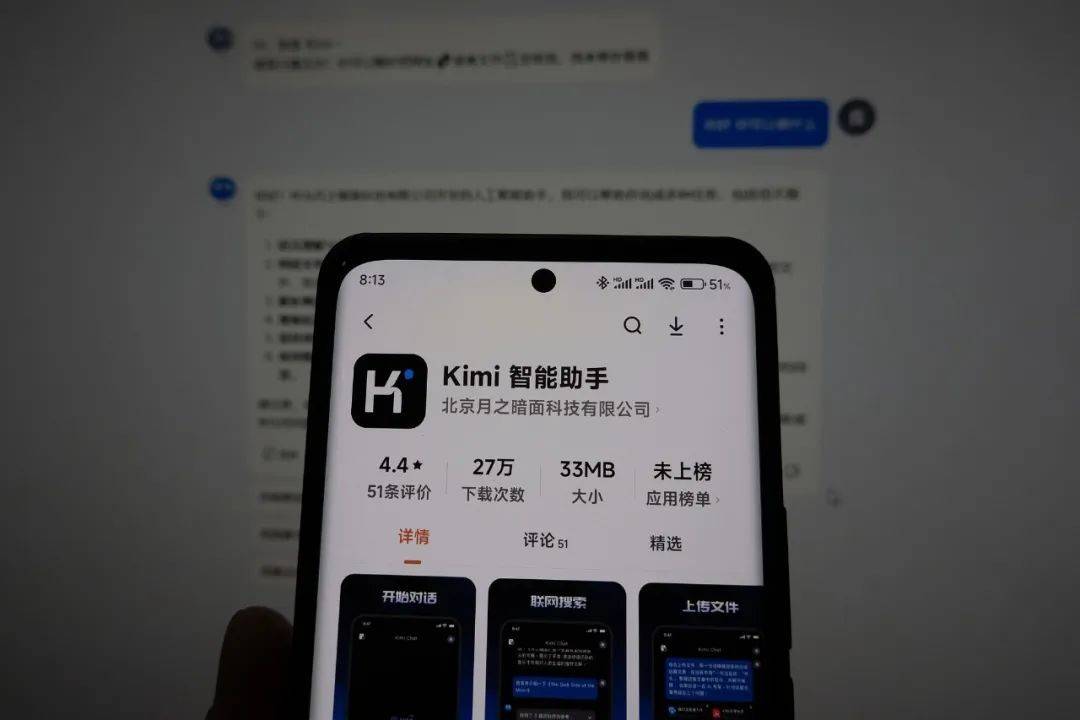DeepSeek's Brilliance: "Eclipsing" Kimi
![]() 02/19 2025
02/19 2025
![]() 611
611

In just a matter of holiday weeks, the global AI landscape has seen a remarkable turnaround due to the emergence of DeepSeek. The seismic impact caused by this Chinese startup and its product continues to reverberate through the global tech community.
On February 5, the popularity of the DeepSeek concept propelled nearly 20 Chinese A-share companies to their daily trading limits. Pingxing Technology, listed on the Beijing Stock Exchange, hit the 30% daily limit, while Meiri Hudong extended its streak with a 20% daily gain. Conversely, the US stock market fared less well. Since January 20, NVIDIA's market value has eroded by 13.84%, TSMC has declined by 3.52%, and even Google and AMD, despite reporting strong growth, have failed to impress Wall Street.
DeepSeek's rise has not only bolstered the confidence of Chinese tech firms but has also inspired Europe, which believes it "still harbors the potential to be a key player in AI innovation."
However, amidst this fervor, Kimi, which unveiled a new model almost simultaneously with DeepSeek, seems to have been relegated to a supporting role.
Is Kimi "out of favor"?
Last year, "everyone was talking about Kimi," but this year, it's "everyone is talking about DeepSeek."
On the eve of the Spring Festival, domestic large models raced to update before the holiday. While DeepSeek released its DeepSeek-R1 model, the Dark Side of the Moon also launched its new Kimi k1.5 model. Both inference models are fully benchmarked against the OpenAI GPT-4 full version. Initially, both DeepSeek and the Dark Side of the Moon's new models sparked heated discussions among overseas user groups upon their release. However, as DeepSeek quickly captivated the AI community, the global technology spotlight was almost entirely on DeepSeek.
In recent days, mainstream European and American media outlets have been "working overtime on weekends and reporting overnight." They used the term "shaking up Silicon Valley" to describe the industry shock it brought to the US. NVIDIA even issued a rare statement praising the R1 model as "an outstanding advancement in AI."
As its popularity continues to soar, DeepSeek's user growth has also accelerated.

According to the latest statistical data released by the domestic AI product ranking, DeepSeek achieved remarkable results just 20 days after its launch. Its daily active user count swiftly surpassed the 20 million mark, reaching a specific figure of 22.15 million, successfully eclipsing Doubao's daily active user count of 16.95 million and reaching 41.6% of ChatGPT's daily active users. Even more impressive, DeepSeek's monthly active user count (MAU) reached 33.7 million just 21 days after its launch.
Amidst DeepSeek's acclaim, Kimi's new model naturally feels somewhat overshadowed. Last year, as the first AI application to break out and successfully explode in the C-end market, Kimi stole the show, and the Dark Side of the Moon's new model was highly anticipated by the industry. However, who would have thought that DeepSeek would make a sensational debut, successfully training a model comparable to ChatGPT-4 at an extremely low cost. Compared to this achievement, the technological progress of Kimi's new model appears less impressive and prominent.
Particularly considering DeepSeek's growth rate, not only surpassing Kimi Intelligent Assistant and ByteDance's Doubao but also keeping pace with ChatGPT globally seems imminent.
DeepSeek's "surprise attack" on Silicon Valley tech companies has not just chilled OpenAI. If DeepSeek occupies the "number one" position in the minds of a large number of users in the domestic market, then the attractiveness of Doubao and Kimi Intelligent Assistant, these two AI applications that briefly led the way, will naturally diminish.
On social platforms, many users have already felt the gap between DeepSeek and Doubao, Kimi Intelligent Assistant, and even after using DeepSeek, they began to "dislike" other large models. One user bluntly stated, "I use both products, but I only use Kimi k1.5 when DeepSeek doesn't respond. It's too mediocre, while DeepSeek always amazes me, especially in terms of imagination."
The shift in user and public opinion, while not causing other products like Kimi Intelligent Assistant to lose their appeal in the short term, could lead to traffic and capital abandoning Kimi and the companies behind it if DeepSeek's advantages overwhelmingly surpass them. Especially for the Dark Side of the Moon, which is known for its aggressive spending, this could mean an even greater crisis.
"Marketing Faction" and "Technological Stream"
In October 2023, Kimi made its debut, backed by a large model with 100 billion parameters, supporting input of up to 200,000 long texts, achieving the global first in dialog box capacity. Five months later, Kimi took a giant leap forward, upgrading to 2 million words.
Taking long texts as its main advantage was the key to Kimi standing out among a crowd of domestic large models. However, Kimi's breakout and popularity, as well as its massive user growth, relied not on technology but on marketing.

Starting from the 2024 Spring Festival, Kimi targeted Bilibili and began a frenetic investment in traffic. At that time, on the homepage of Bilibili or in the video recommendation area, users could always see a promotion link named "Kimi AI Intelligent Assistant." Benefiting from Bilibili, Kimi's traffic showed a significant growth trend, pulling away from other applications and laying the foundation for it to become a phenomenal AI application.
Kimi ignited the war of AI traffic investment, dragging more and more large companies and large model startups into the marketing battle. However, it is undeniable that this move, when China's generative AI had not yet achieved a breakthrough, provided a new path for AI applications to open up the C-end market. Nevertheless, the emergence and popularity of DeepSeek now confirm that domestic large models and applications can fully conquer the market with technological or cost advantages, which poses a certain "threat" to Kimi's "marketing-centric" development path.
Over the past year, Kimi's rapid growth in the C-end market has showcased the potential of a "Killer APP" to the outside world. However, DeepSeek's stunning abilities undoubtedly mean that it is closer to being a "Killer APP" than Kimi.
In fact, the tech community has already questioned the Dark Side of the Moon's large-scale money-burning and marketing-driven user growth strategy.
First, endless traffic investment continuously raises the customer acquisition cost of AI applications, causing great distress to many startups with weak financing capabilities. According to APPGrowing data, since March 2024, Kimi's advertising investment has reached tens of millions of yuan almost every month, with 220 million yuan in October and 200 million yuan in November.
Second, while traffic investment and money-burning have indeed led to a surge in user volume, user retention is not high. Previously, a set of large model retention data circulated in the industry. The data showed that the user retention rate of large model products after 30 days was less than 1%. An industry insider said that retaining users after buying traffic has long been a consensus in the industry, but the current product form may not be able to support it. "Products like Kimi are essentially tools, and their user duration and retention rate are inherently not very high."
Choosing technology or the market is a question that has long been discussed in domestic large models, and the choices and emphases of the companies behind them vary. This divergence has, to a certain extent, caused gaps and discontinuities in the current major AI applications in the C-end market. Originally, Kimi and Doubao's leadership made the outside world more optimistic about the user-oriented "market" grab strategy. However, the emergence of DeepSeek is likely to become an industry watershed, making the technology route the mainstream. Relatively, the effect brought by marketing will only become weaker.
Of course, it's not that Kimi failed to balance technology; it's just that its over-reliance on marketing may affect its future development.
Have Large Models Completely Ended the Era of "Competing" in Long Texts?
Long texts are the technical backbone of Kimi, and it is precisely because of Kimi that domestic large model companies have started to "compete" in long texts and expand contexts. However, this has also led to Kimi's advantage in long texts being reduced.
For example, in November 2024, Alibaba Cloud's Bailian officially launched its new Qwen2.5-Turbo model. The biggest highlight of this model is its support for ultra-long context processing of up to 1 million tokens. According to the latest news, MiniMax has open-sourced its latest basic language model MiniMax-Text-01 and visual multimodal model MiniMax-VL-01. The new model significantly extends the input context window, capable of processing 4 million tokens at once.
In fact, the technical barriers to long text processing are not high. The reason why Kimi was able to use long texts as a selling point and successfully make a name for itself was mainly due to its excellent marketing.
When professional vocabulary related to large models confused the general public, the Dark Side of the Moon emphasized and explained "long texts," forming a deep perception in users' minds and firmly tying the "label" of long texts to Kimi. Even though other large models have surpassed Kimi in long text capabilities, Kimi's popularity last year was not affected.
However, technically speaking, this also means that long text capabilities are difficult to help Kimi build a sustainable competitive advantage. Globally, the overseas large model competition in long text capabilities has already concluded because they found that expanding the context to a certain limit has limited improvement on the model's overall capabilities. Simply put, after the context expansion is sufficient, to improve reasoning abilities, other directions must be explored.

The enthusiasm for competition around long texts in China is likely to cool down as well. The reason is simple: DeepSeek's performance in tasks such as mathematics, code, and natural language reasoning is comparable to that of OpenAI GPT-4's official version, especially its achievements in training costs, which have refreshed the tech community's cognition. Its existence is likely to change or influence the focus and main direction of future large model competition.
As one investor said, the future development of the AI industry does not solely depend on the improvement of computing power but also on technological innovation and cost-effectiveness. Therefore, the flow of funds may also change, shifting from investments that purely pursue high-end computing power to enterprises and projects that place more emphasis on technological innovation and cost control.
Whether it's technological innovation or cost control, the Dark Side of the Moon's advantages are not very significant. On the one hand, within the same time frame and benchmarking against OpenAI GPT-4, the new Kimi k1.5 model launched by the Dark Side of the Moon did not attract as much attention as DeepSeek, which already illustrates the gap. On the other hand, the training costs and the high marketing costs make the Dark Side of the Moon's cost control unconvincing.
In addition, the Dark Side of the Moon still faces an unresolved hidden danger, namely the contradiction between investors and entrepreneurs. At the end of last year, Yang Zhilin, the founder of the Dark Side of the Moon, and Zhang Yutao, the co-founder and CTO, were arbitrated in Hong Kong by investors from their previous company, Recycle Intelligence. The relevant electronic arbitration application has been submitted to the HKIAC (Hong Kong International Arbitration Center).
Being a darling of capital naturally also means bearing the "sweet burden" that capital brings.
Kimi's popularity opened up the development potential of the C-end market for domestic large models, while DeepSeek's explosion provided a greater opportunity for domestic large models to lead the world. Although fortunes change, this undoubtedly indicates the robust innovation capacity of China's large model industry.
Of course, in this fiercely competitive race of technology and capabilities, it is too early to conclude who will win and who will lose.
Dao Zong Youli, formerly known as Waidaodao, is a new media outlet in the Internet and tech community. This article is original and prohibits any form of reproduction without retaining the author's relevant information.





